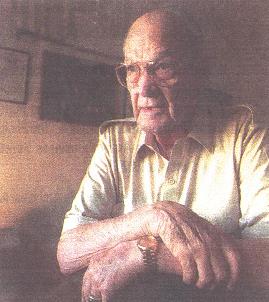Eugene E. Wilson Army Air Corps Hickam Field |
December 7, 1941 a day that will live in infamy for many reasons. I was an Army Air Corps first lieutenant and had just stepped out of my quarters at Hickam Field on the edge of Pearl Harbor that fateful Sunday morning when bombs and torpedoes started raining on Navy Battleship Row. I stood transfixed seeing a Japanese plane drop its deadly cargo. I watched the torpedo as it hit the water and then witnessed the subsequent explosion on one of our battleships. It was difficult to accept what I was seeing and hearing. After the Japanese planes dropped their bombs and torpedoes, they would fly low and strafe buildings, hangars and anything that moved. I suddenly realized one was strafing the very street where I stood. On my left, our Navy ships were being damaged or destroyed; to my right, enemy planes were bombing and strafing Army planes and hangars on Hickam Field. Doubly unfortunate was the timing that had the Japanese attacking at the same time that 12 US B-17 bombers from California were trying to land. Three got on the ground and were immediately destroyed by Japanese fire, and our crews were killed or wounded. As I recall, nine of the B-17s had enough fuel to divert to other island bases. One crash-landed at Bellows Field on the opposite side of Oahu; the others made it to the island of Hawaii. These planes could not offer counter fire, as their armament was packed for the trans-pacific flight and they carried no ammunition. Realizing what was happening, I jumped into my car and headed for my duty station. On the way, I passed the base mess hall, which had taken a direct hit. I saw smoke and fire men stumbling or being carried out from the devastation. I saw a friend of mine pulling a wounded man from the building. I stopped and helped him bring two of the wounded to my car. I tried to get one man into the front seat; he was bleeding badly, and we were still being strafed. My friend refused to accompany me but asked that I find more transportation for the rest of the wounded. We pulled another man into the front seat, and I drove the three to the base hospital. I found a truck there unloading casualties and instructed the driver to go to the mess hall when he was finished. More than 2,000 Americans were killed that day at Pearl Harbor. Of the 141 Army casualties on Hickam Field, 40 had been in or near the mess hall. When I later read the names on the casualty list, I found my friend among those who died. I could not help but speculate that he might have survived had he not elected to remain to help other wounded. The rest of that Sunday was only what could be termed sheer pandemonium. Rumors constantly came in to the command post that a "whole fleet" of the enemy was about to land on Oahu or one of the other islands. One "official report" indicated that hundreds of Japanese paratroopers were descending on Honolulu. All of these reports proved false but caused many problems. That evening, some of our trigger-happy gunners took aim and shot at our own Navy planes as they tried to land after completing patrols. There wasn't much sleep that night, as we had to prepare for the anticipated landings by the enemy. Frankly, had they landed troops after their devastating attacks, they probably could have taken control of the islands. We had neither the means nor personnel to put up effective resistance. Fortunately, they did not follow up their advantage. As I was leaving my duty post the next morning, a call had just come in reporting that a Japanese submarine was foundering between the reefs offshore from Bellows Field. I drove over there in time to watch the so-called two-man suicide submarine being captured. It turned out that seven of these subs had been offloaded by a mother ship disguised as a commercial liner the day before. The subs were supposed to attack military vessels in or around Pearl Harbor. This one sub, captained by Ensign Kazuo Sakamaki, had found its way to the opposite side of the island before foundering in the surf. The mechanic had apparently drowned while being captured. I was later informed that Ensign Sakamaki had been reared and educated in California. He was in Japan visiting relatives in 1939 40 and was "drafted" into the Japanese Navy. As our first official prisoner of war, he probably lived a plush life for the duration. Some six months later and after the Battle of Midway, I was returned to the mainland for rest and recuperation. While awaiting assignment, I was selected to accompany the captured sub on a two-week war-bond-selling tour in Southern California. I spent the last year of the war in North Africa, Italy and Austria. Years later, after serving in Korea, I was with the 18th Fighter-Bomber Group. I retired from the Air Force and joined the space program at Cape Canaveral, FL. In the mid-1960s, I took my family on vacation to the Florida Keys, where I renewed my acquaintance with the captured submarine. I found it in a Navy salvage yard. My curiosity aroused, I made inquiries and was told that Ensign Sakamaki became chief of operations for Toyota Motor Co. in Brazil. Checking further, I learned that the Japanese flight leader for the attack on Pearl Harbor, Commander Mitsuo Fuchida, had, since the war, been ordained by Billy Graham and became a minister in the state of Washington. There has been much speculation in postwar years as to who should bear the responsibility for the Pearl Harbor fiasco. For decades, there was a "curtain" over available facts, and persons involved or knowledgeable were forbidden to divulge information. |
Information provided by Eugene E. Wilson. |
